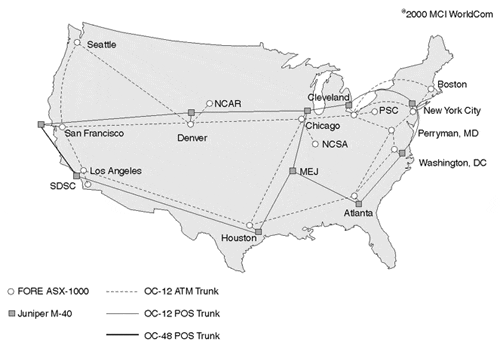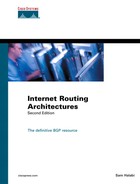The Very High-Speed Backbone Network Service
The very high-speed Backbone Network Service (vBNS)[10] project was created to provide a specialized backbone service for the high-performance computing users of the major government-supported SuperComputer Centers (SCCs) and for the research community.
On April 24, 1995, MCI and NSF announced the launch of the vBNS. MCI's duties include the following:
-
Establish and maintain a 155 Mbps or higher transit network that switches IP and CLNP and connects to all NSFNET-funded NAPs.
-
Establish a set of metrics to monitor and characterize network performance.
-
Subscribe to the policies of the NAP and RA managers.
-
Provide for multimedia services.
-
Participate in the enhancement of advanced routing technologies and propose enhancements in both speed and quality of service that are consistent with NSF customer requirements.
The five-year, $50 million agreement between MCI and NSFNET tied together NSF's five major high-performance communications centers:
-
Cornell Theory Center (CTC) in Ithaca, N.Y.
-
National Center for Atmospheric Research (NCAR) in Boulder, Col.
-
National Center for SuperComputing Applications (NCSA) at the University of Illinois at Champaign
-
Pittsburgh SuperComputing Center (PSC)
-
San Diego SuperComputing Center (SDSC)
The vBNS has been referred to as the research and development lab for the 21st century. The use of advanced switching and fiber-optic transmission technologies, Asynchronous Transfer Mode (ATM), and Synchronous Optical Network (SONET), enable very high-speed, high-capacity voice and video signals to be integrated.
The NSF has already authorized the use of the vBNS for "meritorious" high-bandwidth applications, such as supercomputer modeling at NCAR to understand how and where icing occurs on aircraft. Other applications at NCSA consist of building computational models to simulate the working of biological membranes and to show how cholesterol inserts itself into membranes.
The vBNS is accessible to select application sites through four NAPs in New York, San Francisco, Chicago, and Washington, D.C. Figure 1-7 shows the geographical relationships between the centers and NAPs. The vBNS is mainly composed of OC12 links connected via high-end routers, such as those supplied by Juniper Networks and Cisco Systems. The first OC48c trunk and Juniper routers were commissioned in January 1999.
Figure 1-7. vBNS Backbone Network Map

Reprinted with the permission of MCIWORLDCOM. Copyright 2000. All rights reserved. This material is based upon work supported by the National Science Foundation under Grant Number NCR 9321047. Any opinions, findings, conclusions, or recommendations expressed in this material are those of the author(s) and do not necessarily reflect the views of the National Science Foundation.
The vBNS is a specialized network that emerged due to the continuing need for high-speed connections between members of the research and development community, one of the main charters of the NSFNET. Although the vBNS does not have any bearing on global routing behavior, insight provided by preproduction deployment of new technologies does. The preceding brief overview is meant to give you a background on how NSFNET covered all its bases before being decommissioned in 1995.
Today, the vBNS hosts four SCCs and more than 80 universities at access speeds ranging from DS3 to OC12. Users have deployed IPv6, native multicast services, and MPLS. With April 2000 marking the expiration of the five-year agreement between NSF and MCI WorldCom, current plans are to continue post-April 2000 operation of the vBNS. Funding and support will be made possible by the commercialization of services without an Acceptable Use Policy (AUP), as well by creating a broader target community for services.
Because of its advanced research in QoS and traffic engineering, today it's more commonly referred to as the very high-performance Backbone Network Service. The vBNS continues the tradition begun by NSFNET in this field.
